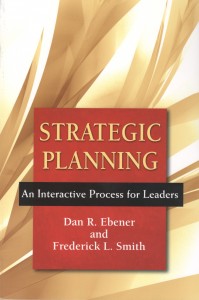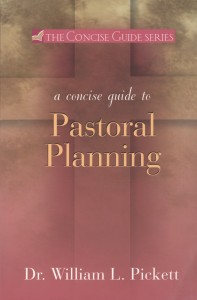Dan R. Ebener and Frederick L. Smith. Strategic Planning: An Interactive Process for Leaders. New York and Mahwah: Paulist Press, 2015. 129 pages. ISBN 978-0-8091-4920-9. $14.95.
William L. Pickett. Concise Guide to Pastoral Planning. Notre Dame: Ave Maria, 2007. 256 pages. ISBN 1-59471-135-6. $16.95.
Review by Mark F. Fischer

Strategic Planning emphasizes the techniques by which participants help an organization plan for change.
Strategic Planning, a new book by Dan Ebener and Frederick L. Smith, covers a lot of the same ground as William L. Pickett’s 2007 volume, A Concise Guide to Pastoral Planning. Both books are about how to improve organizations, both advocate widespread involvement of people in making changes, and both want to solve the problems of participative change, such as building responsibility among followers and getting leaders to respond to them.
The major difference between the two books is their intended readership. Ebener and Smith’s Strategic Planning seeks a broad audience. Its “interactive process” offers to help not-for-profit organizations (such as churches), public or governmental organizations, as well as businesses. Pickett’s Pastoral Planning, by contrast, aims narrowly at Catholic parishes and dioceses.
It is ironic that The Concise Guide to Pastoral Planning, with its narrower Catholic scope, is almost twice as long (254 pages) as Ebener and Smith’s 129-page Strategic Planning. “Concise” is an elastic term. Much of The Concise Guide focuses on Catholic Church leadership and polity – on the relation between pastors and people in parishes and dioceses – which Strategic Planning, with its broader focus, does not discuss.
Brevity v. Specificity
Ebener and Smith define Strategic Planning as “an interactive process where leaders, followers, and managers create a common goal together” (x). They emphasize group process, i.e., the activities performed by members of an organization in an effort to clarify its goals and develop consensus about its future. The underlying assumption is that, if many people in an organization work together to plan its future, they will be more committed to realizing that future.
This is as true for the Davenport Fire Department and the Girl Scouts of Eastern Iowa and Western Illinois (to name two of Ebener and Smith’s clients) as it is for Catholic parishes and dioceses. Strategic Planning does not discuss the unique features of Catholic leadership and ecclesial organization because the group processes that it describes can work with any organization. All can employ the same techniques for getting a group to assess itself, to identify its mission, to articulate its strategies, and to plan its goals. That explains the relative brevity of Strategic Planning. It avoids the complexities of planning in the specifically Catholic environment.
The disadvantage of not discussing church leadership and polity, however, is that for Catholics those terms govern planning absolutely. Here lies the strength of Pickett’s book. He defines his topic this way: “Pastoral planning is the process of praying and thinking together about the actions of the Body of Christ in a particular place and time” (16). Pickett’s process of “praying and thinking” is very much like the “interactive process” of Ebener and Smith, and Pickett’s “Body of Christ” resembles the united community for which Ebener and Smith want to create a “common goal.” But Pickett lays out the specifics of planning for a church with a pastoral and finance council, and with a pastor and a bishop. Ebener and Smith do not discuss them.
Common Planning Features
Strategic Planning and Pastoral Planning have much in common. In Ebener and Smith’s book, the first step is to draw members of an organization into the planning process. “The more people you can involve,” they write, “the more they will take ownership of the plan” (12). Planners then assess their situation by gathering data. After assessing the organizational environment, they articulate their mission and core values. This sets the stage for the intellectual heart of planning: identifying the challenges that face the organization, and defining the strategies that will lead it to a healthy future. This is the future for which the members hope. The final activities are implementing the plan and evaluating its success.
Pickett’s Pastoral Planning defines an almost identical process. Chapter 3 lists the participants, starting with the “pastoral leader” and including the pastoral council, planning team, staff, faith community, and ministry leaders. Chapter 4 lays out the elements in the process: reviewing or creating a mission statement, gathering information, and identifying a church’s concerns. This is, as I said, the intellectual heart of planning – the moment at which planners select, from among the many challenges facing the church, which ones it can reasonably hope to address. The remainder of the process includes the elaboration of goals, objectives, and action plans, the communication of the plan to the church community, and finally its implementation and assessment.
Ebener and Smith’s book excels in its description of the group processes by which organization members assess their strengths, weaknesses, opportunities and threats. We read in Chapter 4, for example, about:
- “conversation cafés” (where people can hold conversations at various tables, just as they would at a café, about the topics assigned to each table),
- “gallery walks” (in which visual learners stroll through a “gallery” hung with various charts depicting the data, all the while looking for overall themes), and
- the “snow card method” (in which participants jot their concerns about the organization on sticky notes and post them on a wall like snowflakes to be gathered by volunteers who will sort and categorize them).
The book vividly illustrates how these techniques can foster conversation. Pickett’s book also includes a description of group process techniques, but in a more prosaic fashion.
Leadership
Both books ask about the leaders who initiate pastoral or strategic planning. Ebener and Smith distinguish their approach from that of other planners. Most of them “assume that leadership is positional and that strategic planning is the purview of people in positions of authority” (x). Ebener and Smith do not make this assumption because they separate the concepts of leadership and management. Management, they say, is “positional authority.” It is “responsible for organizing structural support for the common goal or shared vision” (2). Leadership, by contrast, is a broader concept. Ebener and Smith define it as “a voluntary, interactive process where leaders and followers move each other in the direction of a shared vision or a common goal” (1). So a person who is not a manager and who has no “positional authority” can still be a leader.
Pickett also acknowledges the tension that exists between pastors and parishioners, especially in his discussion of authority in Chapter 1. He distinguishes between “hierarchical” and “communitarian” authority and argues that the two are not exclusive alternatives. Pickett wants “to seek integration [of them] in the mission of Jesus Christ rather than in some final settlement of the ‘governance question’” (34). He points to pastoral councils as an example. “Even though the authority of councils is dependent on the authority and role of pastor and bishop,” he writes, “they have standing and authority in their own right as expressions of the communion of disciples of Jesus Christ” (34-35). Like Ebener and Smith, Pickett believes that people without positional authority (i.e., parishioners who are not priests and bishops) can still be leaders in the Catholic Church.
Participative planning emphasizes the importance of widespread involvement in changing organizations, whether churches, businesses, or governmental organizations. Member participation strengthens motivation and builds commitment. But tensions always remain between those with the “final say” and the member-participants without it. One advantage of Pickett’s book is that he acknowledges these tensions as they manifest themselves specifically in the Catholic world. The consultative priest or bishop is “an authority that serves rather than an authority that is concerned with maintaining and strengthening itself” (35). Such a priest or bishop exercise his “positional authority” by putting himself at the service of his people.
Dan Ebener (himself the author of a 2010 book entitled Servant Leadership Models for Your Parish) and his co-author Frederick Smith discuss the importance of “visionary” leadership to the work of planning. They underline the importance of “unwavering commitment of those in authority” (11). They warn against “passive aggressive behavior” (87) on the part of a leader who outwardly supports planning while covertly undermining it. The authors recognize that good leaders are the ones who initiate strategic planning because they see its benefit to their organization. Although Ebener and Smith do not discuss planning in the specifically Catholic context, nevertheless they want to promote the servant leadership model. In it, leaders consult followers because they recognize that their wisdom and dignity contributes to the well-being of the community.

